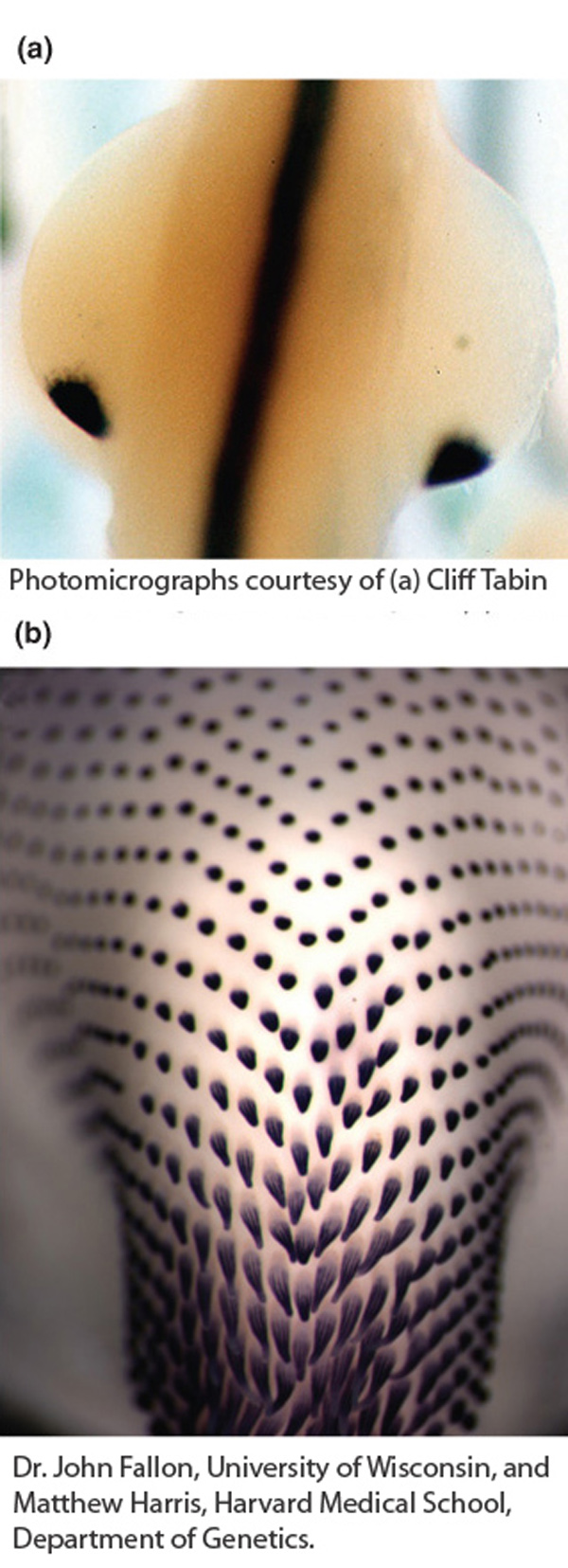13.6
From Flies to Fingers, Feathers, and Floor Plates: The Many Roles of Individual Toolkit Genes
13.6
From Flies to Fingers, Feathers, and Floor Plates: The Many Roles of Individual Toolkit Genes
We have seen that toolkit proteins and regulatory RNAs have multiple roles in development. For example, recall that the Ultrabithorax protein represses limb formation in the fly abdomen and promotes hind-
To illustrate this principle more vividly, we will look at the role of one toolkit protein in the development of many vertebrate features, including features present in humans. This toolkit protein is the vertebrate homolog of the Drosophila hedgehog gene. The hedgehog gene was first identified by Nüsslein-

As the evidence grew that toolkit genes are common to different animal phyla, the discovery and characterization of fly toolkit genes such as hedgehog became a common springboard to the characterization of genes in other taxa, particularly vertebrates. The cloning of homologous genes based on sequence similarity (see Chapter 14) was a fast track to the identification of vertebrate toolkit genes. The application of this strategy to the hedgehog gene illustrates the power and payoffs of using homology to discover important genes. Several distinct homologs of hedgehog were isolated from zebrafish, mice, chickens, and humans. In the whimsical spirit of the Drosophila gene nomenclature, the three vertebrate homologs were named Sonic hedgehog (after the video-
One of the first means of characterizing the potential roles of these genes in development was to examine where they are expressed. Sonic hedgehog (Shh) was found to be expressed in several parts of the developing chicken and other vertebrates. Most intriguing was its expression in the posterior part of the developing limb bud (Figure 13-26a). This part of the limb bud was known for decades to be the zone of polarizing activity (ZPA) because it is an organizer responsible for establishing the anteroposterior polarity of the limb and its digits (Figure 13-26b). To test whether Shh might play a role in ZPA function, Cliff Tabin and his colleagues at Harvard Medical School caused the Shh protein to be expressed in the anterior region of developing chick limb buds. They observed the same effect as transplantation of the ZPA—
Shh is also expressed in other intriguing patterns in the chicken and other vertebrates. For example, Shh is expressed in developing feather buds, where it plays a role in establishing the pattern and polarity of feather formation (see Figure 13-26b). Shh is also expressed in the developing neural tube of vertebrate embryos, in a region called the floor plate (see Figure 13-26a). Subsequent experiments have shown that Shh signaling from these floor-
The dramatic and diverse roles of Shh are a striking example of the different roles played by toolkit genes at different places and times in development. The outcomes of Shh signaling are different in each case: the Shh signaling pathway will induce the expression of one set of genes in the developing limb, a different set in the feather bud, and yet another set in the floor plate. How are different cell types and tissues able to respond differently to the same signaling molecule? The outcome of Shh signaling depends on the context provided by other toolkit genes that are acting at the same time.